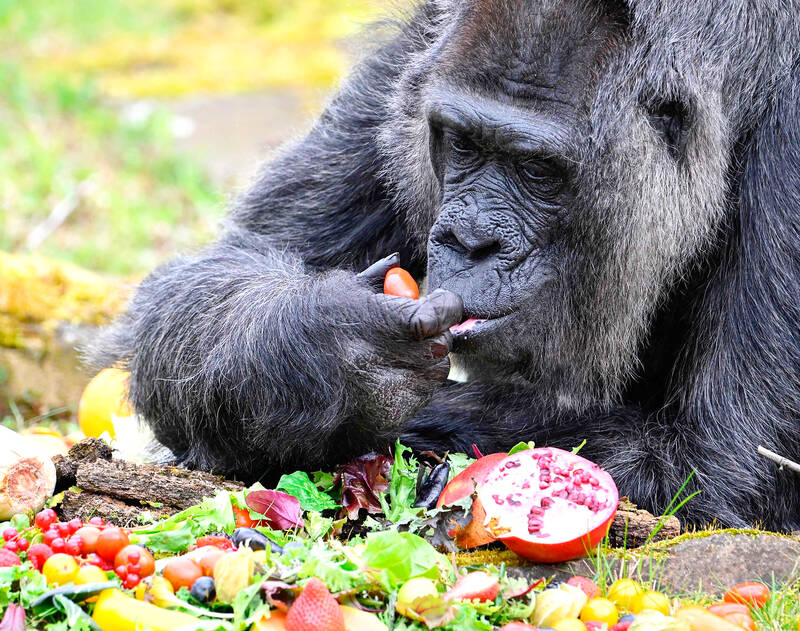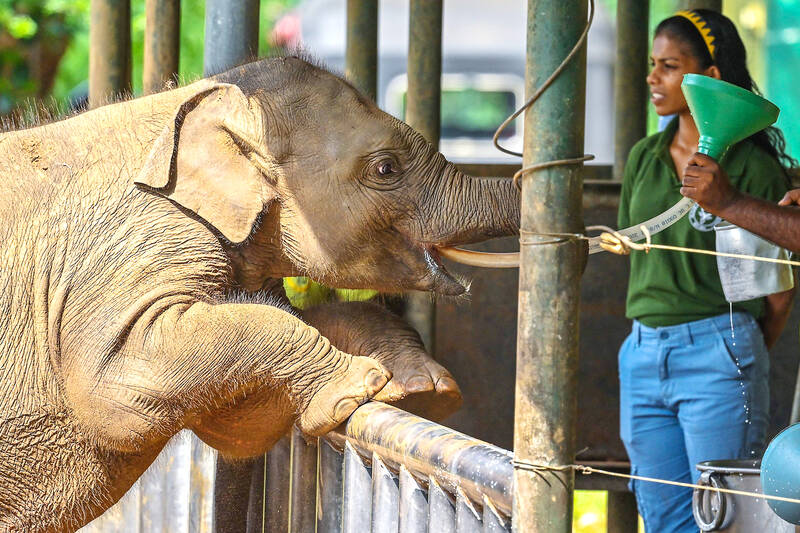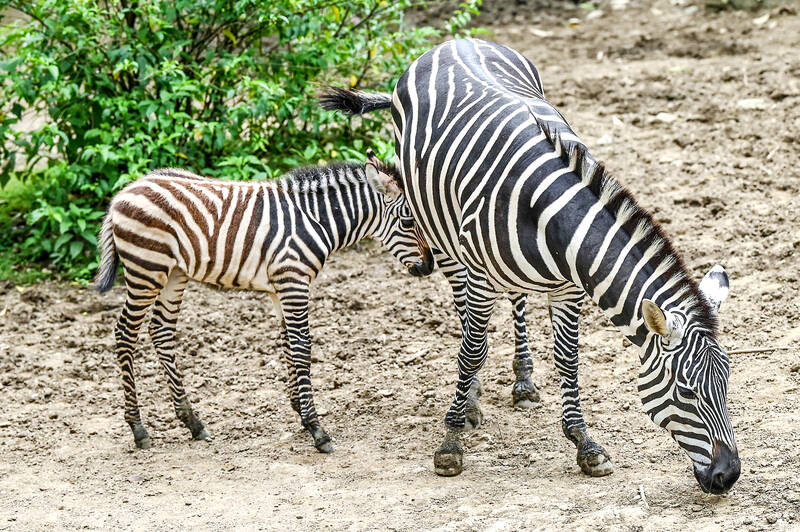A pile of something resembling chocolate raisins is displayed on what looks like a cake base. There’s an artful assemblage of something the size and shape of oysters — and isn’t that chocolate torte and sticky toffee pudding over there?
“They look like something from Bake Off,” says Tracey Lee, an artist and former zookeeper, whose unique collection of animal excrement goes on public display for the first time this weekend in London.
From the distinctive square nuggets of the wombat to the minuscule hand grenades of the death’s head hawkmoth caterpillar, the produce of 120 different rear ends make up The Origin of the Feces: Poo at the Zoo.

Photo: AFP
The exhibition, which opens at Fusebox in Kingston upon Thames, is the result of more than 20 years of collecting, which began for Lee when she had to say goodbye to her favorite elephant, Geetha. One evening in 2001, she loaded the elephants on to trucks to move them from London Zoo to ZSL’s sister zoo, Whipsnade, so they could enjoy more space.
“When you work with these animals you fall in love with them. They become your family,” she says. “You’re with them from 7:30 in the morning until 6:30 at night. If they’re sick, you stay overnight with them. You’re there on Christmas Day. As the truck left and drove out into the dark, I remember feeling really bereft. It was awful. I picked up one of Geetha’s poos, held it and thought, ‘This is the last thing I have of Geetha.’”
Lee was awakened to the artistic potential of number twos in the 1990s when, as elephant keeper, she collected elephant dung for the artist Chris Ofili, drying it in the zoo’s boiler room.

Photo: AFP
When London Zoo’s rhinos, Rosie and Jos, were also moved to more spacious zoos, Lee took another memento.
“I know you shouldn’t have favorites but I just loved Jos to bits. I picked up his poo and put it next to Geetha’s in the boiler room. I know it sounds weird. And that’s how it began.”
Over the next two decades, Lee assembled her collection, drying out the stools and storing them in a friend’s barn and in her allotment shed. She would visit friends working at other zoos and leave with a car boot-load of crap.

Photo: AFP
For authentic splatter, she drops them on to a mount from the same height as the animal’s bum, and preserves them in PVA glue.
Although now odorless and hygienic, the exhibits are a feast for the senses.
Okapi (forest giraffe) manure looks like glossy chocolate raisins. Zebra dung is the same shape and size as oysters. The sizeable discharge of the Galapagos tortoise “looks like a giant tadpole or sperm with the tail on them,” thinks Lee, who two years ago moved from keeper duties to become ZSL’s “creative operative” — painting zoo spaces, leaflets and signs.
Elephant excrement is unexpectedly modest but they produce 10 or more of each chunk at a time. The strangest fecal matter belongs to Zaire, one of London Zoo’s most cherished gorillas, who died three years ago. It looks like a giant kebab.
“She was an absolutely wonderful animal, funny and intelligent and just beautiful,” Lee says. “She was very greedy and used to barge everyone out of the way to get the best bits of food — she did giant poos because she ate so much.”
The exhibition includes donations from endangered birds — collected on canvasses placed below their favorite perches — reptiles and invertebrates.
The stinkiest — before being dried and made hygienic — belonged to the African wild dog. The smallest offering was probably the grape seed-sized poos of the Partula snail, extinct in the wild but being reintroduced via captive-breeding programs.
The exhibition, which runs until Oct. 28, already has more than 1,000 schoolchildren booked to see it.
Robin Hutchinson, founder of the exhibition organizers The Community Brain and the charity Creative Youth, says: “This is a brilliant exhibition because it gives visitors permission to talk about poo — and that’s something that appeals to people of all ages. I’m especially keen to use Tracey’s amazing exhibition to connect young people to the real plight of the natural world.”
But one mammal is not represented in the collection. “The only one I haven’t done is human,” says Lee. “Please don’t ask — no way!”

June 2 to June 8 Taiwan’s woodcutters believe that if they see even one speck of red in their cooked rice, no matter how small, an accident is going to happen. Peng Chin-tian (彭錦田) swears that this has proven to be true at every stop during his decades-long career in the logging industry. Along with mining, timber harvesting was once considered the most dangerous profession in Taiwan. Not only were mishaps common during all stages of processing, it was difficult to transport the injured to get medical treatment. Many died during the arduous journey. Peng recounts some of his accidents in

“Why does Taiwan identity decline?”a group of researchers lead by University of Nevada political scientist Austin Wang (王宏恩) asked in a recent paper. After all, it is not difficult to explain the rise in Taiwanese identity after the early 1990s. But no model predicted its decline during the 2016-2018 period, they say. After testing various alternative explanations, Wang et al argue that the fall-off in Taiwanese identity during that period is related to voter hedging based on the performance of the Democratic Progressive Party (DPP). Since the DPP is perceived as the guardian of Taiwan identity, when it performs well,

The Taiwan People’s Party (TPP) on May 18 held a rally in Taichung to mark the anniversary of President William Lai’s (賴清德) inauguration on May 20. The title of the rally could be loosely translated to “May 18 recall fraudulent goods” (518退貨ㄌㄨㄚˋ!). Unlike in English, where the terms are the same, “recall” (退貨) in this context refers to product recalls due to damaged, defective or fraudulent merchandise, not the political recalls (罷免) currently dominating the headlines. I attended the rally to determine if the impression was correct that the TPP under party Chairman Huang Kuo-Chang (黃國昌) had little of a

At Computex 2025, Nvidia CEO Jensen Huang (黃仁勳) urged the government to subsidize AI. “All schools in Taiwan must integrate AI into their curricula,” he declared. A few months earlier, he said, “If I were a student today, I’d immediately start using tools like ChatGPT, Gemini Pro and Grok to learn, write and accelerate my thinking.” Huang sees the AI-bullet train leaving the station. And as one of its drivers, he’s worried about youth not getting on board — bad for their careers, and bad for his workforce. As a semiconductor supply-chain powerhouse and AI hub wannabe, Taiwan is seeing